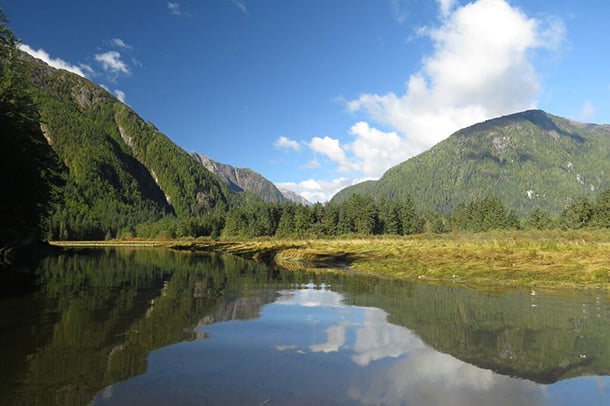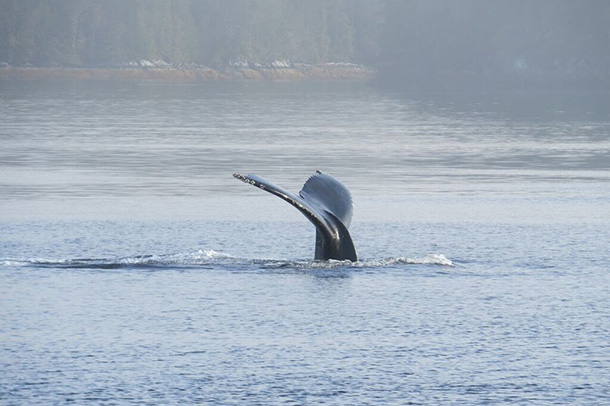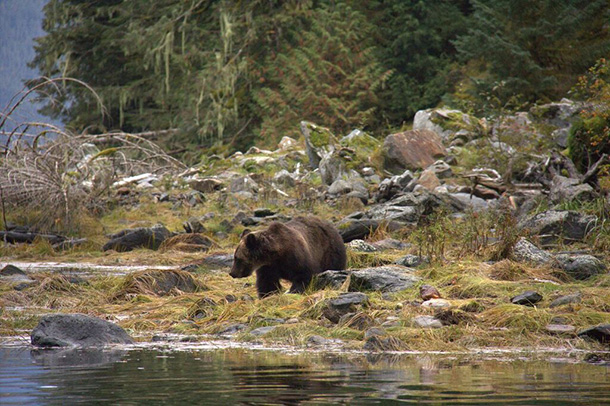The provincial government and over 20 First Nations signed agreements in Vancouver today that finalize land use planning for the central and northern coast of British Columbia.
More than a year overdue, but supported by representatives of both environmental groups and forestry companies, the agreements are the next step in a process that protects large swaths of the area known as the Great Bear Rainforest.
"It's a very big deal, because we are demonstrating solutions are possible," said Jens Wieting, forest and climate campaigner for the Sierra Club BC. "Eighty-five per cent of the forest will be off limits to logging."
Rick Jeffery, the president and CEO of the Coast Forest Products Association, said it's been an intense three years nailing down the final details and carefully considering possible consequences. "It's an incredibly complex agreement," he said. "The work that's ongoing right now is a freaking grind."
He adds, though, that, "The real story here is the collaborative process."
Art Sterritt, who was executive director of the Coastal First Nations until he retired in September, said that the agreements are an important step but not the end of the path.
"We don't get as warm and fuzzy as others," he said. "Coastal First Nations are always going to be there, and there are always going to be tweaks. Land use planning never ends."
Decades in the making
The Great Bear Rainforest agreement has been decades in the making. Pitched as a way to get beyond the valley-by-valley war in the woods in B.C., the process brought together First Nations, forestry companies, environmental groups, local governments and the provincial government.
The parties agreed to the broad principles in 2004, followed by agreements in 2006 and 2009 aimed at protecting the rainforest, improving logging practices, involving First Nations in decision-making and providing funding for economic diversification.
The area covered is 6.4 million hectares, which Wieting pointed out is twice the size of Vancouver Island. Under the final agreement, some 3.1 million hectares will be completely off limits to logging, he said. That amounts to 85 per cent of the forest ecosystems in the area.
The other 15 per cent, about 500,000 hectares, will be available for forestry but governed by rules Wieting called "stringent," requiring the companies to manage the land for objectives that include protecting waterways, endangered species and cultural values.

Since the 2009 agreement, the amount of forest protected from logging overall has increased, and the number of protected areas will increase from 136 to 144 this year, Wieting said (from 2.1 million hectares to 2.4 million hectares).*
The agreement is laudable for how the parties moved from confrontation to collaboration and for how it recognizes that economic activity has to respect the limits of nature, he said. It creates a more coherent forestry framework for the region and protects a whole range of representative ecosystems.
Critics on all sides
Sterritt, who is Gitga'at, said there was delay getting to today's announcement because it took time to get some of the affected communities onside. "There's never been any doubt that the Coastal First Nations as a group, they were going to complete [the agreement]," he said.
While some want to declare the process done and move on, land use planning is always a work in progress, he said. "That's this year's plan," he said. "It's not as big a deal for the Coastal First Nations. We're more iterative.... We'll be there forever."
Plans need to be updated regularly to adapt to future conditions, he said. For example, climate change might alter the growth rate for the forest, allowing or requiring harvest levels to be revisited. "Every year, you update your plan," he said. "There's always flexibility. If they see something to do, you just do it."
Jeffery said the agreement includes monitoring and a review in 10 years. "No plans last forever," he said.
Including the Great Bear Rainforest, some 4.5 million hectares are protected on the coast of B.C., or about 55 per cent, Jeffery said. "That's a big number. Nowhere else in the world can say that."

In his 30 years in the business, the size of clearcuts has shrunk and logging practices have improved, he said. The two million hectares of working forest on Crown land on the coast is managed to protect views, species at risk and other values, he said. "We do it better than anyone else by a long shot."
The agreement will have critics, likely on all sides. For example, the Vancouver Sun reported last week that scientists are critical of the agreement for its failure to fully protect Gribbell Island, an important habitat for the white Kermode or spirit bears, a black bear subspecies.
Wieting said 80 per cent of Gribbell will be off limits to logging, and any logging activity will be held to a high standard. He said overall the agreement protects much of the land where the bears live.
He added that while there are good reasons to protect the island, in any negotiation there are trade-offs. "It's just very difficult to insist a specific area should become a protected area if First Nations are still in discussions on it or there may be a problem with a forestry company," Wieting said.
*Story updated for clarity Feb. 2 at 11:45 a.m. ![]()
Read more: Indigenous, BC Politics, Environment
















Tyee Commenting Guidelines
Comments that violate guidelines risk being deleted, and violations may result in a temporary or permanent user ban. Maintain the spirit of good conversation to stay in the discussion.
*Please note The Tyee is not a forum for spreading misinformation about COVID-19, denying its existence or minimizing its risk to public health.
Do:
Do not: